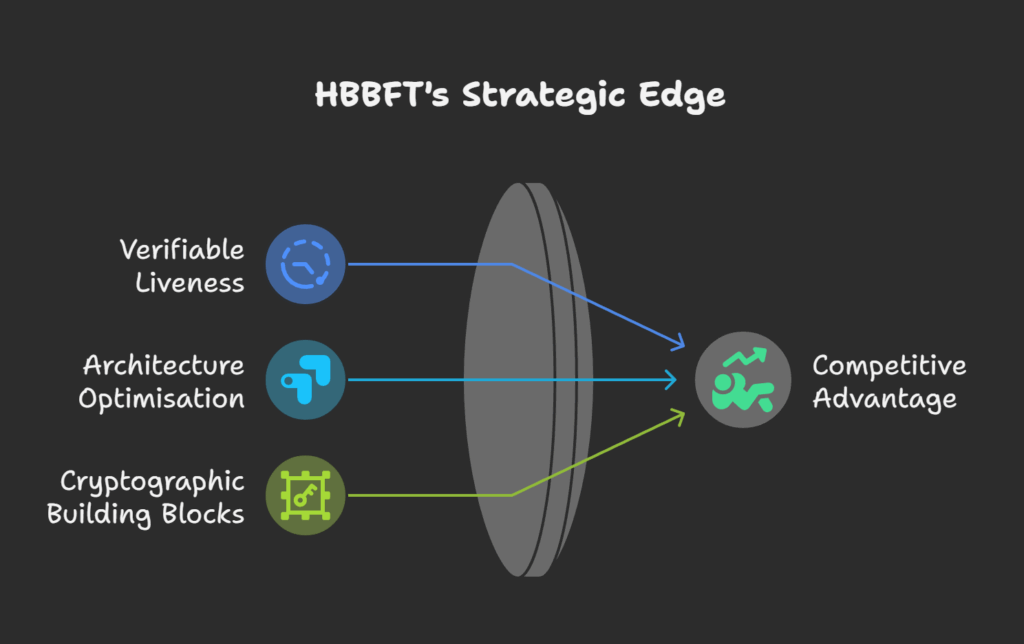The Honey Badger of BFT protocols

The groundbreaking asynchronous Byzantine Fault Tolerant (ABFT) consensus system HoneyBadgerBFT (HBBFT) was created to address the crucial problems of reaching consensus and atomic broadcast in network settings with unpredictable and limitless message delays. Being the first workable asynchronous BFT protocol that ensures liveness without depending on any temporal assumptions, it stands apart from the competition.
This is a thorough analysis of HoneyBadgerBFT:
Dealing with Asynchronous Environments
- Because HBBFT was designed to work well in completely asynchronous network environments, it can continue to function and advance even in the face of persistent communication delays caused by a hostile network controller.
- This feature is essential since under such extreme asynchronous circumstances, conventional “weak synchronous” BFT protocols, as Practical Byzantine Fault Tolerance (PBFT), would lose their functionality or become ineffective. In decentralised cryptocurrency situations, where network links can be unstable, speeds can fluctuate, and delays can be intentionally caused, the creators contend that protocols that rely on timing assumptions are not appropriate.
- Because it always advances as soon as messages are delivered, regardless of network circumstances, HBBFT’s architecture suggests that it “does not care” about the underlying network.
Fundamental Process: Threshold Encryption in Atomic Broadcast
- HoneyBadgerBFT’s distinctive atomic broadcast technology is one of its main innovations. This is accomplished by combining threshold encrypted data with a novel batching technique to improve the common asynchronous subset (ACS).
- For censorship resistance, threshold encryption is essential. It stops selective delays of proposals from particular nodes by keeping an adversary from knowing which proposals are coming from until after an agreement is established. This guarantees that once a transaction reaches the front of the queue with enough valid nodes, an attacker cannot stop it from being committed.
- Even when there are network outages, the system can still come to a consensus to this method.
Alos Read About Raft in Blockchain Use Cases, Advantages, And Disadvantages
Modular Methodology and Elements
There are five main modules that make up HoneyBadgerBFT’s modular approach:
HoneyBadgerBFT
The top-level module that carries out the overall atomic broadcast (consensus) is called HoneyBadgerBFT.
Asynchronous Common Subset (ACS)
Each node can propose a value using the Asynchronous Common Subset (ACS) primitive, which guarantees that each node produces a common vector with the input values of at least N-2f valid nodes. The effective implementation of ACS by HBBFT outperforms previous techniques.
Reliable Broadcast (RBC)
Nodes use Reliable Broadcast (RBC) to spread their suggested values. It guarantees broadcast communications’ legitimacy, agreement, and wholeness. Erasure coding greatly increases efficiency by lowering the transmission cost from O(N^2|v|) to O(N|v| + λN^2 logN).
Asynchronous Binary Agreement (ABA)
This method selects a bit vector that shows which RBCs have finished successfully. For a single bit, it ensures validity, agreement, and termination. A common coin used in cryptography is used to instantiate it.
CommonCoin
A distributed object that ensures uniform sampling of the random value that is impervious to adversary influence until it is disclosed by delivering the same sequence of random bits to every process. A special threshold signature mechanism makes it possible.
Scalability and Performance
- With its remarkable performance characteristics, HBBFT has proven to be able to process thousands of transactions per second.
- In difficult synchronous network scenarios, it has demonstrated the capacity to scale up to a thousand nodes while retaining performance. Throughputs of thousands of transactions per second were attained in experiments conducted on Amazon EC2 with more than 100 nodes spread over five continents. For networks with up to 40 nodes, the peak throughput exceeded 20,000 transactions per second. It achieved more than 1,500 transactions per second for a network with 104 nodes.
- In the asynchronous context, the protocol attains maximal asymptotic efficiency. Its efficiency is 0(1) per committed transaction for input buffers that are adequately full.
- HoneyBadgerBFT performs better than PBFT in suboptimal synchronous network settings and guarantees liveness in situations where PBFT might completely fail. In contrast to PBFT, which reduces throughput as the number of nodes increases, HBBFT evenly distributes the load, allowing its throughput to stay relatively constant. Even with high and fluctuating latency, HBBFT managed to execute over 800 transactions per second across the Tor anonymous relay network without the need for parameter tuning.
Also Read About What Is Mean By IBFT Istanbul Byzantine Fault Tolerance?
Competitive Advantage

- Verifiable liveness in an asynchronous setting is a feature that sets HBBFT apart from other protocols, such as Gosig, which may have lower performance costs but sacrifice this feature. As soon as messages are sent, it starts to move forward.
- By optimising its architecture for cryptocurrency-like deployment scenarios, where CPU is relatively abundant but network bandwidth is scarce, it can take advantage of cryptographic building blocks such as threshold public-key encryption.
Suggested Deployment Scenarios
- A good part of cryptocurrency-inspired fault-tolerant transaction processing system implementations is HoneyBadgerBFT.
- A conglomerate collaboratively contributes to a Byzantine agreement protocol for quick and reliable transaction settlement over a wide-area network, possibly involving hundreds to thousands of consensus nodes. This makes it an ideal candidate for “confederation cryptocurrencies” or “permissioned blockchains,” which are sought after by banks and other financial institutions.
- By using HBBFT, randomly chosen committees could achieve high throughput and response times comparable to traditional BFT protocols, providing the best of both worlds in open enrolment, decentralised networks. It is also applicable to permissionless blockchains.
Implementation Details
Using the gevent package for concurrent activities, a Python prototype implementation of HoneyBadgerBFT was created.
It makes use of the Charm/PBC library for threshold cryptography, namely Baek and Zheng’s threshold encryption method and Boldyreva’s pairing-based threshold signature scheme, and the Zfec library for Reed-Solomon erasure coding. The groundbreaking asynchronous Byzantine Fault Tolerant (BFT) consensus system HoneyBadgerBFT (HBBFT) was created to address the crucial problems of reaching consensus and atomic broadcast in network settings with unpredictable and limitless message delays. Being the first workable asynchronous BFT protocol that ensures liveness without depending on any temporal assumptions, it stands apart from the competition.
